-
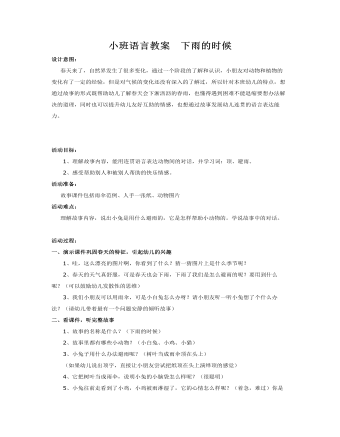
小班语言教案 下雨的时候
活动目标:1、理解故事内容,能用连贯语言表达动物间的对话,并学习词:顶、避雨。2、感受帮助别人和被别人帮助的快乐情感。活动准备: 故事课件包括雨伞范例、人手一张纸、动物图片活动难点: 理解故事内容,说出小兔是用什么避雨的,它是怎样帮助小动物的。学说故事中的对话。 活动过程:一、演示课件巩固春天的特征,引起幼儿的兴趣1、哇,这么漂亮的图片啊,你看到了什么?猜一猜图片上是什么季节呢?2、春天的天气真舒服,可是春天也会下雨,下雨了我们是怎么避雨的呢?要用到什么呢?(可以鼓励幼儿发散性的思维)3、我们小朋友可以用雨伞,可是小白兔怎么办呀?请小朋友听一听小兔想了个什么办法?(请幼儿带着最有一个问题安静的倾听故事)
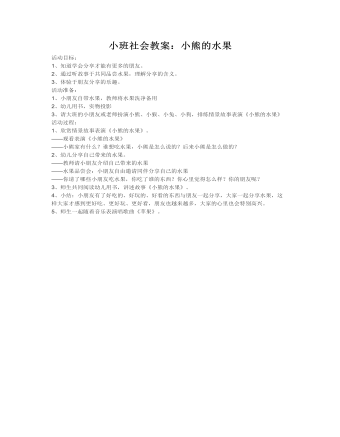
小班社会教案:小熊的水果
2、通过听故事于共同品尝水果,理解分享的含义。 3、体验于朋友分享的乐趣。 活动准备: 1、小朋友自带水果,教师将水果洗净备用 2、幼儿用书,实物投影 3、请大班的小朋友或老师扮演小熊、小猴、小兔、小狗,排练情景故事表演《小熊的水果》 活动过程: 1、欣赏情景故事表演《小熊的水果》。 ——观看表演《小熊的水果》 ——小熊家有什么?谁想吃水果,小熊是怎么说的?后来小熊是怎么做的?
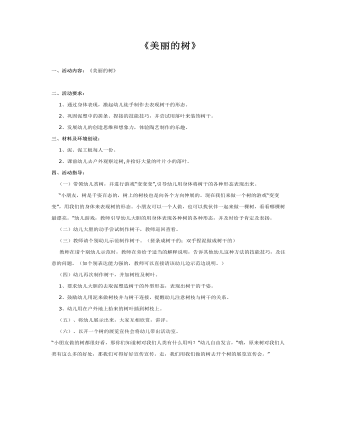
陶艺教案:美丽的树
二、活动要求: 1、通过身体表现,激起幼儿徒手制作去表现树干的形态。 2、巩固泥塑中的搓条、捏接的技能技巧,并尝试用落叶来装饰树干。 2、发展幼儿的创造思维和想象力,体验陶艺制作的乐趣。三、材料及环境创设: 1、泥、泥工板每人一份。 2、课前幼儿去户外观察过树,并拾好大量的叶片小的落叶.四、活动指导: (一)带领幼儿赏树,并进行游戏“变变变”,引导幼儿用身体将树干的各种形态表现出来。 “小朋友,树是千姿百态的,树上的树枝也是向各个方向伸展的。现在我们来做一个树的游戏“变变变”,用我们的身体来表现树的形态。小朋友可以一个人做,也可以找伙伴一起来做一棵树,看看哪棵树最漂亮。”幼儿游戏,教师引导幼儿大胆的用身体表现各种树的各种形态,并及时给予肯定及表扬。
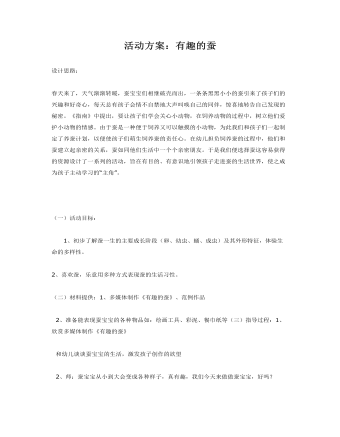
美术教案:有趣的蚕
(一)活动目标: 1、初步了解蚕一生的主要成长阶段(卵、幼虫、蛹、成虫)及其外形特征,体验生命的多样性。 2、喜欢蚕,乐意用多种方式表现蚕的生活习性。(二)材料提供:1、多媒体制作《有趣的蚕》、范例作品 2、准备能表现蚕宝宝的各种物品如:绘画工具、彩泥、餐巾纸等(三)指导过程:

综合教案有用的报纸
一次,我有意将废旧报纸投放于晨间桌面、体育区、语言区、表演区等各区域活动,惊奇的发现,晨间桌面他们会用它来折飞机呀、撕碎片呀、团纸球呀,语言区、表演区他们会像真有回事儿似的学爸爸、奶奶看报呀……在成人眼中不起眼的废旧报纸真的成了孩子们的宝贝。经过多次仔细观察,我发现孩子们虽然兴趣浓厚,可对报纸的玩法、利用性还是存在着局限性。新《纲要》中指出:幼儿是教育活动的积极参与者而非被动接受者,活动内容必须与幼儿兴趣、需要及接受能力相吻合。我想,作为教师,应根据幼儿的兴趣、需要和原有经验,引导幼儿走向最近发展区。由此产生了中班综合活动——《有用的报纸》。开展这一活动,孩子们要有一定的基础。我班幼儿已有折、剪、团等用废旧报纸制作的经验。这一活动适合于中班下学期的小朋友。活动设计:一、活动目标1、帮助幼儿理解故事内容,增强爱惜报纸、保护环境的意识2、了解废旧报纸的再可利用性,能想方设法利用废旧报纸,对报纸制作产生兴趣二、重点、难点1、故事内容以及对故事中报纸不同情绪的感知2、想方设法再利用废旧报纸及用旧报纸制作三、活动准备1、事先排练四位大班幼儿担任小小模特儿的角色(身穿报纸服装、头戴报纸头饰,手拿报纸道具,如:纸伞、纸球、纸棒、纸辫子等随乐表演)2、废旧报纸许多,剪刀、胶水、水彩笔、旧图书、白纸、蜡笔、蛋、脏皮鞋等3、轻音乐、故事录音(见后)4、多媒体课件5、事先排练好二段情境表演四、活动过程1、幼儿观看模特儿表演,初步感知旧报纸的用途师:哎呀!小朋友们快看,来了一群小小模特儿,她们身上的衣服多有趣呀!(幼儿观看表演,模特定格)提问:(1)她们身上的衣服是什么做成的呀?(报纸) (2)报纸做的衣服漂亮吗?(漂亮)报纸还做成了些什么呀?(纸球、纸棒、纸辫子、纸伞、纸扇子等)

美术会变的半圆课件教案
2、能给图画添加背景。3、养成认真观察物体的习惯。活动准备:各种半圆形若干、胶水、蜡笔、记号笔活动过程:一、 导入部分,引起幼儿的兴趣。1、昨天,老师做了一个梦,梦见一位仙女,她有一根魔术棒,她走过每一个地方,用魔棒一指,那些五彩的半圆形的石头就会变成各种东西,非常神奇。小仙女也送给老师一根魔术棒,我们也一起来变一变,好吗?
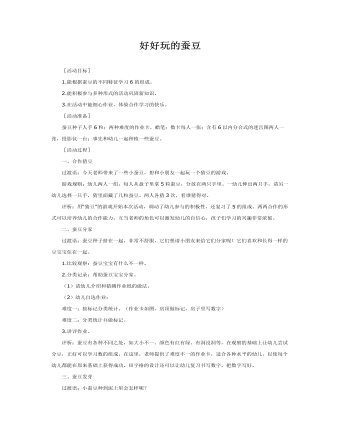
好好玩的蚕豆课件教案
2.能积极参与多种形式的活动巩固新知识。3.在活动中能细心作业,体验合作学习的快乐。 [活动准备] 蚕豆种子人手6粒;两种难度的作业卡,蜡笔;数卡每人一张;含有6以内分合式的迷宫图两人一张,投影仪一台;事先和幼儿一起种植一些蚕豆。 [活动过程] 一、合作猜豆 过渡语:今天老师带来了一些小蚕豆,想和小朋友一起玩一个猜豆的游戏。 游戏规则:幼儿两人一组,每人从盘子里拿5粒蚕豆,分放在两只手里。一幼儿伸出两只手,请另一幼儿选择一只手,猜里面藏了几粒蚕豆。两人各猜3次,看谁猜得对。 评析:用“猜豆”的游戏开始本次活动,调动了幼儿参与的积极性,还复习了5的组成。两两合作的形式可以培养幼儿的合作能力,互当老师的角色可以激发幼儿的自信心,孩子们学习的兴趣非常浓郁。

《冬天的秘密》主题活动教案
一:活动背景: 随着天气的变冷及幼儿外出活动发现的落叶,使幼儿对冬天的到来有了初步的感知,对他们来说寒冷的冬天太奇妙、太神奇了,他们想揭开冬天的面纱,他们对冬天渴望探索更多的知识。如:他们会问:为什么树叶会在冬天落下来、冬天为什么会很冷、冬天为什么会下雪、门窗上为什么有冰花,还有的幼儿说:冬天冷水会结冰,我们可以滑冰玩、冬天下雪我们可以堆雪人、冬天冷就不会有蚊子不会被蚊子咬了等等。结合幼儿对冬天所产生的神秘感和已了解的知识内容,我们开展了主题活动——冬天的秘密,借此,让幼儿对冬天有更全面的认识,揭开冬天的秘密。 首先,我们在幼儿中开展调查,发现大部分幼儿对冬天的冷都感到可怕,这对他们来说可能对四季交替不够了解,这需要我们的引导讲解,通过调查我们还发现幼儿对冬天的万物变化非常感兴趣,特别是:下雪、动物的冬眠,从幼儿的好奇心出发,我们决定以冬天的变化为着眼点,进行主题活动的开展。 二:活动的目的: 1. 活动中,让幼儿了解冬天的各种变化、动植物的过冬方式及不同地方的不同过冬方式。 2. 冬天的活动及冬天的节日,使幼儿对冬天由更进一步的了解,从而对冬天有更深的认识。 三;主题活动网络图: 昼长夜短 寒冷 雪花、冰雹 变化 的冬季 冬眠、南迁、躲 天气 现象 不同地方 储备食物、冬眠、 圣诞节、元旦、春节 冬天的景色 过冬方式 冬天的节日 冬天的秘密 动物 动物趣闻 冬天的活动 植物人类的变化 衣服的变化 蔬菜、庄稼 跳绳、堆雪人 制作漂亮 树、花 食物 疾病 取暖 天冷我不怕 踢毽子 的冬装 常绿树、落叶树 预防感冒 树叶找家 注: 为教师预设内容、 师生共同生成、 为幼儿生成
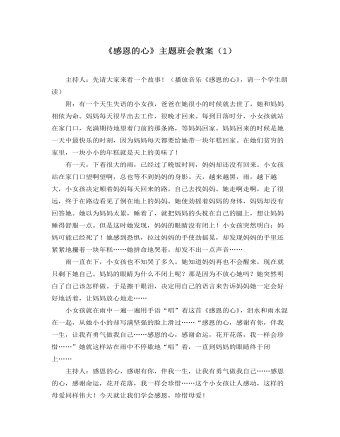
《感恩的心》主题班会教案(1)
主持人:然而我们又是怎样对待我们的父母的呢?下面我们来做个调查?你是否了解你的妈妈?1、你妈妈的生日是_________。2、你妈妈的体重是_________。3、你妈妈的身高是________。4、你妈妈穿_______码鞋。5、你妈妈喜欢颜色是________。6、你妈妈喜欢水果是________。7、你妈妈喜欢的花是________。8、你妈妈喜欢的日常消遣活动是_____________。请你如实回答。把你的答案写在一张纸寄给你妈妈评分答对6题以下的请你以后多与妈妈沟通。主持人:其实值得感恩的不仅仅我们的母亲,我们对父亲、师长、亲朋、同学、社会等等都应始终抱有感恩之心。我们的生命、健康、财富以及我们每天享受着的空气阳光水源,都应该在我们的感恩之列。一位盲人曾经请人在自己的乞讨用的牌子上这样写道:“春天来了,而我却看不到她。”我们与这位盲人相比,进一步说与那些失去生命和自由的人相比,目前能这样快快乐乐地活在世界上,谁说不是一种命运的恩赐,我们还会时常愤怒得发抖而总去抱怨命运给自己的不幸和不平吗?
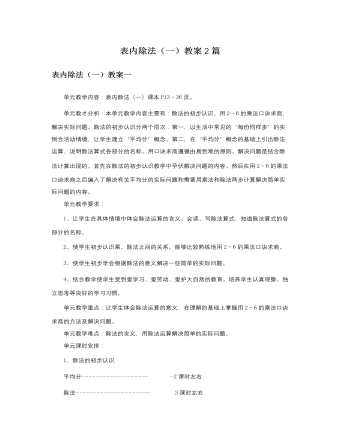
人教版新课标小学数学二年级下册表内除法(一)教案2篇
教后反思本节课给学生创设了良好的活动空间,把学生实际生活中听说过的见到的平均分现象展示给学生看,把生活和数学联系起来,在学生感受“同样多”的基础上概括出什么叫平均分。揭示平均分这一数学知识在生活中的应用,之后突出了学生三次实际操作。第一次,小组同学互相分水果,重视学生分的结果。体会感受“平均分”的含义。第二次,重视分法:15个橘子平均分成5份。体现了学生对物品的不同分法,建立了平均分的概念。第三次,分矿泉水,通过份数变化,观察分的就结果,深刻体会“平均分”,为认识除法积累丰富的知识。为学生营造探索的空间。第二课时:平均分的认识(二)教学内容巩固“平均分”。课本第15页的例题3。教学目标1.巩固“平均分”的概念,知道平均分就是每一份分得结果同样多。
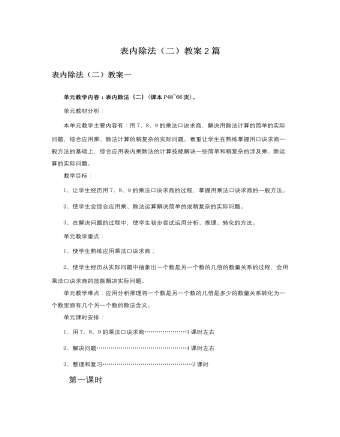
人教版新课标小学数学二年级下册表内除法(二)教案2篇
三维目标1.知识与技能(1)让学生经历用7、8、9的乘法口诀求商的过程,掌握用乘法口诀求商的一般方法。(2)使学生会综合应用乘、除法运算解决简单的或稍复杂的实际问题。2.过程与方法在解决问题的过程中,让学生初步尝试运用分析、推理和转化的学习方法。3.情感、态度与价值观让学生在学习中体验到成功的喜悦,增强学生学好数学的信心。重、难点与关键1.重点:使学生熟练应用乘法口诀求商,经历从实际问题中抽象出一个数是另一个数的几倍的数量关系的过程,会用乘法口诀求商的技能解决实际问题。2.难点:应用分析推理将一个数是另一个数的几倍是多少的数量关系转化为一个数里面有几个另一个数的除法含义。3.关键:以解决问题为载体,培养学生的数感。

部编版语文九年级上册《中国人失掉自信力了吗》教案
一、导入新课我们已经学过鲁迅先生的不少文章,学过他的小说,看他用无数生动的形象表达他在时代里的“呐喊”与“彷徨”;学过他的散文,与他一同在失落中“朝花夕拾”,安静地回忆过往。今天,我们将学习鲁迅先生的一篇杂文,看他是如何作为民族斗士,将手中的笔,变成抨击敌人的枪。二、教学新课目标导学一:学习驳论,理清思路1.初读课文,找出对方的错误观点,并说说作者是怎样引出这一观点的。明确:对方的错误观点是“中国人失掉自信力了”。开篇以似乎确凿的事实为据,用一句话指出了三个阶段中“中国人”表现出来的三种不同的态度:盲目骄傲,夜郎自大;盲目崇拜,借助外援;今不如昔,祈求鬼神。即由自夸到崇洋,到自欺欺人、虚无渺茫的态度变化。因此有人“慨叹”:“中国人失掉自信力了。”这是论敌的论点。

人教版新目标初中英语八年级上册How do you get to school教案2篇
Step Ⅶ Role play ( Work on 1b)1. First ask two students to read the dialogue to the class.Sa: How do you get to school?Sb: Well, I ride my bike to the subway station. Then I take the subway.2. Now work with a partner.Suppose you use two kinds of transportation to get to school \Hangzhou\Beijing... (bus, train, subway, walking, bike, etc.) Tell how you get there. You may use the phrases in 1a.3. Then ask different pairs of students to present their conversations to the class.Step ⅧListening1. Work on 2a(1) First ask students to read the list of information that Thomas wants to know.…where Nina lives.…how far from school she lives.…how long it takes to get to school.…how she gets to school.…what she thinks of the transportation.(2) Tell students what transportation and bus stop mean.bus stop 汽车站 transportation n. 运送;运输Then tell students we'll hear a recording. Please put a checkmark in front of each thing that Thomas wants to know.(3) Now play the recording for students.( Have students pay attention to the sample answer.) (4) Then correct the answers.

人教版新目标初中英语九年级上册Teenagers should be allowed to choose their own clothes教案2篇
Step 1 Greeting Greet the class and check the homeworkStep 2 A duty report The S on duty gives a report on the rules in his home and lead in 3a “Sun Fei’s and Wu Yu’s rules” Step 3 ReadingSs read the conversation and write the two girls’ rules in the chart. Check the answers.Get Ss to read after the tape and then read aloud by themselves. Then, T explains the language points.Step 4 Pairwork 3bRole play. Use the information in chart to practice with the conversation in 3a covered. They can look at the sample conversation in the right box.Step 5 Task 2 “Who’s the best reporter?”Make a survey by asking any 5 students the questions in the chart in activity 4. Then give out a report about it. See who is the best reporter? And the best reporter will get a nice ball-pen.Step 6 Summary and homework:Write out the report in your exercise-books.Period ThreeStep 1 Greeting and a duty reportThe S gives a duty report talking about his experience of being late for school. Lead in the question “Do you ever get to school late? How often do you get to school late? Always, usually, sometimes, or never?Step 2 1a Get Ss to finish writing.Step 3 Pairwork 1b Get Ss to talk about their answers with their partners using the sample conversation in the box on the right.Step 4 Listening practice2a Lead-in: What will happen if you get to school late? What about Peter? Let’s listen to a conversation between Peter and his father. Get Ss to finish 2a (As usual, for the first time, Ss only listen.) Check the answers.

人教版新目标初中英语九年级上册How do you study for a test教案2篇
内容提示本单元主要内容是学会利用verb十by/with gerund表示方式方法来讨论学习英语的策略,认识自己在学习方面的长处和不足。初步了解现在完成时的结构和用法。现在完成时由助动词have/has+动词的过去分词构成,主要表示过去发生的某一动作对现在仍有影响或造成的后果,常与already,yet,just,ever,never等副词连用。教学目标一、学习目标(Language Goal) 1. Talk about how to study . 学会讨论各种学习方法和策略。2. Find out your suitable learning methods. 找出适合自己的学习方法。 二、语言结构(Language Structures) 1. Verb + by with gerund by+动名词短语 表示“通过…途径,方法” 2. How questions have引导的特殊疑问句 三、目标语言(Target Language) 1. How do you study for tests ? 你是怎样准备考试的?Well , I study by working with my classmates. 哦,我和同学们一起学习。2. Have you ever studied with a group ? 你曾经参加过学习小组吗?Yes , I have . I’ve learned a lot that way . 是的,参加过。通过这种方式我学了许多。

人教版新目标初中英语九年级下册We’re trying to save the manatees教案2篇
本单元主要围绕着有关濒临灭绝的动物这一话题,学习了应该怎样保护我们的环境,以及就某一问题展开辩论。目标提示语言目标能够运用所学知识,就某一问题展开辩论。认知目标1、复习一些语法:现在进行时、一般现在时、用used to 表示一般过去时、现在完成时、一般过去时的被动语态。2、学会表达同意和不同意。3、学会以下基本句型:We’re trying to save the manatees.Manatees eat about 100 pounds of food a day.There used to be a lot of manatees.In 1972,it was discovered that they were endangered.Some of the swamps have become polluted.情感目标了解一些濒临灭绝的动物的生活习性和濒临灭绝的原因,教育学生应该如何保护环境。教学提示充分利用多媒体等教学设备,创设与本课话题相关的情境,如各种不同种类的动物、动物园以及有关环境的画画等等。围绕着本单元的教学目标,设计一些贴近学生实际的教学任务,如让学生谈论自己最喜欢的动物,如何拯救濒危动物,如何保护环境等等。让学生根据所学知识,就动物园是否对动物有利以及其他的话题进行辩论。

人教版新目标初中英语七年级下册How was your weekend教案2篇
Teaching Goal:1. General aims:Talk about recent past events2. Particular aims:A. Language Focus.Talk about recent past events and think of the past events.B. Language goalsHow was….?It was …What did …do over the weekend?C. Language structures:(1). How was your weekend? I was great. Pay attention to no form.(2). What did you do over the weekend? I played soccer. We went to the beach.D. Useful words and phrases:Words: was, did, went, beach, over, project, test, wasn’t, false, number, geography, spend, week, most, mixture, their, had, little, cook, read, saw, change, everyone, sit, sat, no, anythingPhrases: did one’s homework, played soccer, cleaned my room, went to the beach, played tennis, went to the movies, on Saturday morning, over the weekend, cook … for, what about, do some reading, have a party, talk show, go shoppingE. Grammar language:Present simple past tenseRegular and irregular verbsF. Learning strategies:Tour and holidaysG. Interdiscipinary:H. Emotion and manner:Teaching time: 5 periodsTeaching procedures:Period One教学步骤、时间 教师活动 学生活动 媒体应用Step 1Free talk 3’ Ask some questions like:Who’s on duty today?What’s the weather like? Answer and talk about something.让同学们回答下列问题1. Do you like weekend? (Let some students answer)It takes them three minutes to talk about the question.2. Why do you like weekend? (let the students answer) Most of the students like the weekend此时教师用汉语问:“在周末期间问你干了什么?这句话用英语这么回答?Let the students guess.At last the teacher give them right answer3. What did you do over the weekend?(板书、学习)

人教版新目标初中英语七年级下册Where is the post office教案2篇
Period 2 (3a----Section B 2c)Preview(Pre-task): Key points: What laAdd another information about their pen pals----their language on the cardnguage does she/he speak?She/He speaks....Does she/he have any brothers and sisters? Does she/he speak English?Preview(Pre-task): Add another information about their pen pals----their language on the cardKey points: What language does she/he speak?She/He speaks....Does she/he have any brothers and sisters? Does she/he speak English?Step 1 Revision1.Revisionand dictation of the new words 2.Revise the drills they learned yesterday.(by pairwork and grammar exercise)Step 2 Leading-inT has a conversation with one student. The conversation is following:---Do you have a pen pal?---Yes, I do.---What's your pen pal's name? ---His/Her name is....---Where is your pen pal from? ---He/She is from...---Where does he/she live? ---He/She lives in....---What language does he/she speak?He/She speaks...Write the new words on the Bb. They are following: EnglishChineseJapaneseFrenchStep 3 LearnLearn the new words with the whole class.Finish 3a with the students3b Pairwork T still does an example with one student Then the Ss practise in pairs. The example is following:--Curry Muray is my pen pal. He is from the United States.---What language does he speak?

人教版新目标初中英语七年级下册Don’t eat in class教案2篇
Don’t fight. =You can’t fight. (板书,教读)教师把这些句子板书在黑板上,并请学生大声整齐地读祈使句和“can’t”句型,并让学生注意两种句型表达形式的不同和转换,“Don’t …=You can’t…”;并对学生说:These are our school rules. (板书,教读) You can’t break the school rules. Don’t break the school rules.(板书,教读)步骤3 :Practicea. T: Now, each of the students is breaking one of these rules.Please finish 1a.学生看图,完成1a的内容,检查答案并大声朗读校规。b. 听录音,完成1b,选出四位学生都违反了哪条校规;听之前,学生要读会英文名。c. 请两位学生朗读1c部分的句型;要求学生两人一组对话表演,SA扮演外校转来新生,SB告知本校校规。(学生可经过讨论,多说出他们想到的校规,不必只限于书上;教师应给予帮助)2) 第二课时(2a~4)步骤1 :warming up of revisionT: What are the rules at your school?学生使用“can”或祈使句表达各条校规;其中老师可引出“eat in the cafeteria outside”的表达。步骤2 :Practicea.T: Christina is an exchange student. She doesn’t know the rules. Let’s listen, what activities they’re talking about?学生听第一遍时,完成2a;第二遍时,完成2b;b. 请学生领读2c部分,看着2a完成的表格,理解2c活动的要求;分成小组针对2a进行问答;

人教版新目标初中英语七年级下册I want to be an actor教案2篇
三、教学建议第一课时:1. Lead in (Vocabulary)A) Before class, teacher should collect some pictures of working places. For example: Bank, TV Station, Restaurant, Police Station, Hospital ...B) In class, show students the pictures (PowerPoint, OHP). Ask students to tell the name of the working places and the name of the jobs.Shop assistant, doctor, actor, reporter, police office, waiter, bank clerk, studentC) Do exercise 1a and 3a.2. Bingo GameAsk groups of students to make up pairs of cards with a job on one and the related workplace on the other. For example, waiter / restaurant, teacher / school, doctor / hospital. Encourage students to use both the job / workplace combinations in the book and the ones that students came up during class discussions. Be sure they have twice as many sets of cards as there are students in the group. They can make two sets of cards for a single job / workplace, if necessary. Then have each group mix up its set of cards and hand their cards out in random order. Each time a student gets a pair of cards that match, he or she can lay these cards down. The goal is to have no cards in your hand at the end.3. Task OneA) Ask students to work in pairs and ask the partner what does he / she want to be in the future.e. g. :What do you / does he / does she want to be?I want to be a.Why?Because it's (adj).B) Vocabulary: Section B, 1a4. Homework 1.2.

